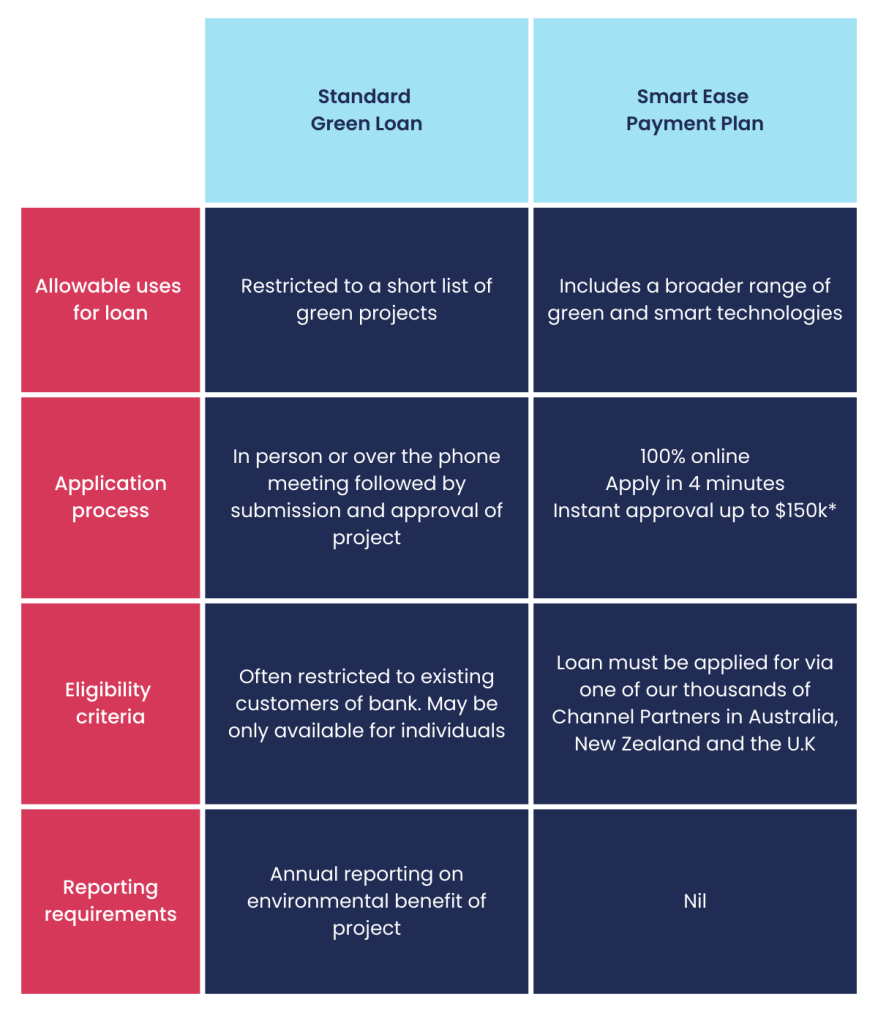In recent years, green loans have rapidly risen from obscurity to become top-of-mind.
The benefits of decarbonisation – such as cheaper energy through renewables, positive brand implications, and keeping shareholders happy – have convinced most organisations of the need to act soon. Green loans and similar payment solutions (including our own) play a key role in this for small- to medium-sized organisations.
For organisations keen to reduce their footprint by adopting solar power and other technologies – without digging in to their savings – investigating green loans and related options is a wise move.
So, what are green loans, what alternatives exist, and what’s best for your organisation?
What are green loans?
Green loans were first introduced as a government initiative to encourage individuals (vs businesses) to install energy-saving home improvements.
Today, they’re also used in commercial settings as businesses seek to rapidly decarbonise their operations in an era of ESG and skyrocketing power prices.
In simple terms, a green loan is ‘a form of financing that enables borrowers to finance projects that have an environmental impact’.[1] The concept has existed under different names (including ‘green bonds’ and ‘green financing’) for around 15 years, but since 2018 they’ve been classified according to a specific set of principles. These are:
- The use of funds. The use of the loan should be clearly described in the financial documents and offer clear, verifiable environmental benefits.
- The process of evaluation and selection of projects. The borrower should clearly inform the lender of the sustainability objectives and how they determined that the project is eligible.
- The management of funds. The amount of the green loan should be recorded in a specific account and be able to be tracked to ensure transparency and integrity.
- Annual review. The borrower should show how the funds are being used on an annual basis to demonstrate they’re meeting objectives.[2]
How do green loans work for businesses?
When cash flow is inconsistent or capital is earmarked for other projects, green loans and similar products are one way for organisations to access technology like solar panels, EV chargers, batteries and energy-efficient lighting. These technologies allow organisations to reduce the amount of energy they source from the grid, often drastically, which can also reduce their monthly expenditure.
Interest rates for green loans vary depending on the provider, with some lenders advertising lower rates with proof of environmental impact. To qualify, businesses must meet a strict set of criteria and commit to ongoing reporting, as per the Green Loan Principles (see above).

“There is no company whose business model won’t be profoundly affected by the transition to a net zero economy.”
Larry Fink, CEO Blackrock
Due to the need to vet each application for its environmental value, green loans through banks can only be applied for in person or via the phone. Many major lenders only offer green loans to existing customers and only to individuals, not organisations. Due to these types of requirements, the maximum loan amount is often too low to be viable for businesses to use (for example, $20,000).
How do Smart Ease Payment Plans compare to green loans?
It’s important to note that while Smart Ease payment solutions are based on green-loan principles, they are not classified as green loans. Differences between green loans and Smart Ease payment solutions are mainly related to the strictness of criteria and the reporting requirements.
At Smart Ease, we solve the same problems as green loans do, but in a more flexible and business-friendly way. The most obvious and important difference between Smart Ease payment solutions and a green loan from a bank is in the paperwork – and the speed.
Our payment solutions are unique. They’re fast (it takes less than 5 minutes to apply), they’re 100% online and they can be used to fund a broad range of energy-efficiency technologies.
Most importantly, our payment solutions can only be accessed via our Accredited Channel Partners, which is how we know that we’re funding projects with a positive environmental impact. This means you’re able to apply online quickly, with less paperwork and hassle than you’re likely to encounter with traditional lenders.
Once your equipment is installed and your project is complete, there is no reporting required to demonstrate the environmental impact of your loan.
*Subject to credit criteria and approval
Green loans and their equivalents are here to stay. As decarbonisation continues across all sectors, expect this option to be more commonly used by organisations of all sizes to achieve their green goals.
Smart Ease customers love the win-win of reducing their energy expenditure and their carbon footprint at the same time – and they love the accessibility of our payment solutions for all organisations, regardless of their bank or their reporting capacity.
We know you will too.
Enquire about a Smart Ease Payment Plan today
[1] Climate Explainer: Green Loans (worldbank.org), sourced 16 Jan 2023
[2] As above, sourced 16 Jan 2023
[3] Green Financing: A Look at the History – Bechtel, sourced 16 Jan 2023


